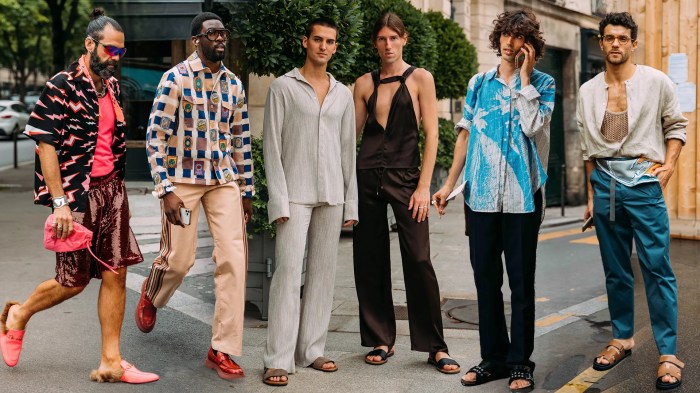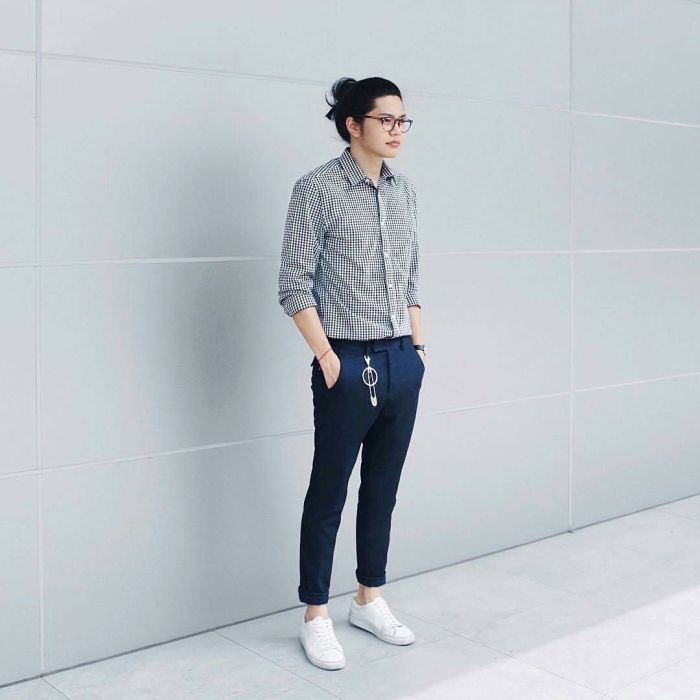Types of Fashion Men A Style Guide
Men’s Formal Wear
Types of fashion men – Formal wear for men demands precision and attention to detail. Understanding the nuances of fabrics, styles, and accessories is crucial for achieving a polished and sophisticated look. This section explores the key elements of men’s formal attire, covering everything from suits and tuxedos to the perfect accessories.
Tuxedos, Suits, and Formal Shirts: A Comparison

Source: vogue.com
The following table compares tuxedos, suits, and formal shirts, highlighting key differences in fabric, occasion, and styling.
| Feature | Tuxedo | Suit | Formal Shirt |
|---|---|---|---|
| Fabric | Typically wool, silk, or a wool-silk blend. Often features satin lapels. | Wool, linen, cotton blends. Variety of weights and textures available. | Fine cotton, often with a high thread count. Can include piqué or other textured weaves. |
| Appropriate Occasions | Black-tie events, formal galas, weddings. | Business meetings, weddings (depending on formality), formal dinners. | Worn with suits and tuxedos. |
| Styling Tips | Pair with a bow tie, cummerbund or waistcoat, and patent leather shoes. | Consider a tie, pocket square, and dress shoes appropriate for the occasion. | Ensure a proper fit, avoiding overly tight or loose collars. Choose a color that complements the suit. |
Single-Breasted vs. Double-Breasted Suits
The primary difference lies in the buttoning style. Single-breasted suits have a single column of buttons, typically two or three, offering a more streamlined and versatile look suitable for various occasions. Double-breasted suits, featuring two overlapping columns of buttons, project a bolder, more powerful image. They often appear more structured and are best suited for more formal events.
The choice depends largely on personal preference and the desired level of formality.
Appropriate Accessories for Formal Men’s Attire
Accessories play a vital role in completing a formal look. Cufflinks add a touch of elegance and personalization, while tie bars maintain a neat and professional appearance. Pocket squares, subtly peeking from the breast pocket, inject personality and style, adding a final layer of sophistication. The choice of materials and colors should complement the overall outfit.
Casual Men’s Fashion
Casual wear offers a wide range of styles and options, allowing for self-expression and comfort. Building a versatile casual wardrobe requires understanding key pieces and how to combine them effectively for various occasions.
Essential Casual Wardrobe Items
A well-curated casual wardrobe includes essential pieces adaptable to different seasons and styles. The following list highlights key items:
- T-shirts: Crew neck, V-neck, in various colors and fabrics (cotton, linen).
- Shirts: Oxford cloth button-downs, chambray shirts, linen shirts.
- Jeans: Various washes and styles (straight leg, slim fit, etc.).
- Chinos: Versatile trousers in various colors.
- Jackets: Denim jacket, bomber jacket, lightweight field jacket (seasonal variations).
- Sweaters: Crew neck, cardigan, in different weights and materials (cotton, wool, cashmere).
- Sneakers: Canvas sneakers, leather sneakers, running shoes.
Versatility of Denim Jeans
Denim jeans are a cornerstone of casual men’s fashion, offering remarkable versatility. Different washes (light, dark, distressed) and styles (slim fit, straight leg, relaxed fit) allow for diverse styling options, ranging from a casual weekend look to a more refined smart casual ensemble. Pairing them with a crisp white shirt, a t-shirt, or a blazer offers a wide range of possibilities.
Styling Tips for Combining Casual Pieces
Layering is key to creating interesting and stylish casual outfits. Combining a t-shirt with a button-down shirt, adding a jacket or sweater, and choosing appropriate footwear allows for dynamic and adaptable looks. Color coordination and attention to fit are also crucial aspects of successful casual styling.
Men’s Streetwear Styles
Streetwear encompasses a diverse range of sub-styles, each with its own unique characteristics and influences. Understanding these sub-styles helps in navigating the world of streetwear fashion.
Three Distinct Streetwear Sub-Styles
This section compares three prominent streetwear sub-styles:
- Hip-Hop: Characterized by oversized silhouettes, bold graphics, and a focus on comfort and self-expression. Often incorporates elements of sportswear and vintage apparel.
- Skate: Defined by durable, functional clothing designed for skateboarding. Emphasizes comfort, mobility, and often features loose fits and durable fabrics.
- Techwear: Focuses on high-tech fabrics, functional designs, and a futuristic aesthetic. Often incorporates waterproof, breathable materials and advanced construction techniques.
Common Streetwear Brands
Numerous brands are associated with men’s streetwear, each catering to different sub-styles. Examples include (but are not limited to): Supreme (Hip-Hop/Skate), Palace (Skate), Stone Island (Techwear), and A Bathing Ape (Hip-Hop).
Evolution of Streetwear
Streetwear’s evolution reflects shifts in culture and technology. Originating in the 1980s and 90s from subcultures like hip-hop and skateboarding, it has grown into a global phenomenon, incorporating influences from various cultures and incorporating technological advancements in fabric and design.
Men’s Accessories
Accessories are the finishing touches that elevate an outfit. From watches and belts to hats and jewelry, the right accessories can significantly enhance a man’s style and reflect his personality.
Various Men’s Accessories
| Accessory | Materials | Styles | Impact on Outfit |
|---|---|---|---|
| Watches | Leather, metal, ceramic | Dress watches, sport watches, smartwatches | Adds sophistication, reflects personal style |
| Belts | Leather, fabric, metal | Formal, casual, designer | Complements trousers, adds structure |
| Hats | Wool, cotton, straw | Baseball caps, fedoras, beanies | Adds personality, protects from sun/cold |
| Wallets | Leather, fabric | Bifold, trifold, cardholders | Practical and stylish |
Impact of Different Footwear
Footwear significantly impacts overall style. Sneakers offer comfort and casual appeal, boots project ruggedness and sophistication, while loafers add a touch of elegance. The choice of footwear should complement the outfit and the occasion.
Incorporating Jewelry
Jewelry, when used thoughtfully, can enhance a man’s look. A simple watch, a subtle ring, or a tasteful necklace can add a personal touch. The key is to avoid over-accessorizing and choose pieces that complement the outfit and the occasion.
Men’s Fashion by Body Type
Understanding your body type and choosing clothing that flatters your silhouette is crucial for looking your best. This section offers styling advice for different body types.
Styling Advice for Different Body Types, Types of fashion men
Different body types require different approaches to clothing. Slim builds benefit from layering and structured garments to add volume. Athletic builds can showcase their physique with fitted clothing. Muscular builds can emphasize their strength with tailored pieces, while larger builds benefit from vertical lines and dark colors to create a slimming effect. The fit of the clothing is paramount in achieving a balanced and visually appealing look.
Creating a Balanced Look
The goal is to create visual balance and proportion. This might involve using strategic layering, color blocking, or specific cuts to create the illusion of a more balanced physique. For example, vertical stripes can elongate the frame, while darker colors can create a slimming effect.
Importance of Fit
Proper fit is paramount. Clothing that is too tight or too loose will not flatter any body type. Well-fitting clothes will enhance the silhouette and create a polished look. It’s advisable to get clothes tailored for the best fit.
Men’s Fashion Through the Decades

Source: atome.id
Men’s fashion has undergone significant transformations throughout history. Examining trends from different decades reveals the influence of cultural movements and societal shifts.
Men’s Fashion Trends Across Decades
Comparing men’s fashion from the 1950s, 1980s, and 2000s reveals distinct stylistic differences. The 1950s featured clean lines, tailored suits, and a focus on elegance. The 1980s saw a rise in power dressing, with broader shoulders and bolder colors. The 2000s embraced a more casual aesthetic, with influences from streetwear and hip-hop.
Influence of Historical Events
Historical events and cultural movements significantly impacted men’s fashion choices. Post-war prosperity in the 1950s led to a focus on sophisticated attire. The economic boom of the 1980s reflected in the “power suit” trend. The rise of globalization and technology in the 2000s contributed to the adoption of more casual and diverse styles.
Iconic Men’s Fashion Looks

Source: stylerave.com
Men’s fashion encompasses a broad spectrum, from casual streetwear to sophisticated formal wear. A particularly interesting niche within this diverse landscape is men’s academic fashion, which often blends classic styles with a modern edge; you can explore this further at mens academic fashion. Ultimately, the best style for any man depends on individual preferences and the occasion, reflecting his personality and taste.
Iconic looks include the sharp suits and slicked-back hair of the 1950s, the oversized suits and bold accessories of the 1980s, and the varied styles influenced by hip-hop and streetwear of the 2000s. Each decade’s fashion reflected the social and cultural climate of the time.
Frequently Asked Questions: Types Of Fashion Men
What are some key differences between slim-fit and regular-fit clothing?
Slim-fit clothing hugs the body more closely, while regular-fit offers a more relaxed and comfortable fit. The choice depends on personal preference and body type.
How can I incorporate more color into my wardrobe without looking overly flashy?
Start by incorporating subtle pops of color through accessories like ties, socks, or pocket squares. Gradually introduce bolder colors into your shirts or outerwear, always considering the overall balance of your outfit.
What are some essential accessories for a professional setting?
A quality leather belt, a simple watch, and well-maintained dress shoes are essential. A subtle tie bar or cufflinks can add a touch of sophistication.
How do I choose the right size when buying clothes online?
Consult the retailer’s size chart carefully, paying close attention to measurements. Read customer reviews to gauge the fit and sizing accuracy of the garment.





















